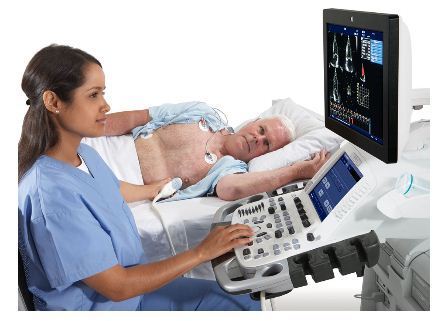2D Echo

Book an Appointment
Introduction
Your heart, the tireless engine of your body, deserves the best care. And when it comes to understanding its health, 2D echocardiography (2D Echo) is a valuable tool. This painless, non-invasive imaging technique offers a real-time window into your heart’s chambers, valves, and blood flow, providing crucial information for diagnosis and treatment.
What is 2D Echocardiography?
2D Echo uses sound waves to create detailed images of your heart in motion. A transducer, a handheld device resembling a microphone, is placed on your chest. It emits sound waves that bounce off your heart structures and return to the transducer. These echoes are then converted into electrical signals and processed by a computer to create a moving image on a screen – your heart’s live performance!
What can 2D Echo Reveal?
This powerful technique can uncover a range of heart conditions, including:
- Valve problems: Leaky, narrowed, or malfunctioning valves can disrupt blood flow and affect heart function. 2D Echo can pinpoint the affected valve and assess its severity.
- Chamber size and function: Enlarged or weakened heart chambers can indicate heart failure or other issues. 2D Echo measures the chambers’ size, shape, and pumping ability.
- Wall motion abnormalities: Irregularities in heart wall movement may indicate damage or disease. 2D Echo can visualize these abnormalities and help diagnose conditions like cardiomyopathy.
- Congenital heart defects: Defects present at birth can be identified using 2D Echo, aiding in early diagnosis and treatment planning.
- Blood clots: 2D Echo can detect blood clots within the heart chambers, which can pose a risk of stroke or other complications.
Benefits of 2D Echocardiography:
- Safe and painless: No radiation or needles involved, making it suitable for all ages and conditions.
- Non-invasive: No need for incisions or catheters, offering comfort and convenience.
- Detailed visualization: Provides real-time images of your heart’s structures and their movement.
- Versatility: Can be used to diagnose a wide range of heart conditions.
- Dynamic assessment: Shows how your heart functions under different conditions, like rest and exercise.
- Cost-effective: Compared to other imaging techniques like MRI, 2D Echo is a relatively affordable option.
General Instructions
- Always wear comfortable clothing that is easy to change or partially remove from the waist up.
- Patient generally lies on his/her left side on the exam table.
- A water-based gel is applied to the area where transducers will move to monitor the heart functionality.
- A cardiologist or a cardio technician performing the procedure will run transducer across the chest area.

